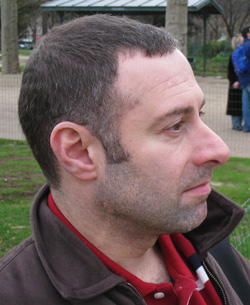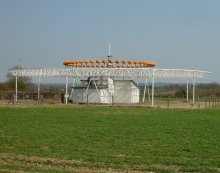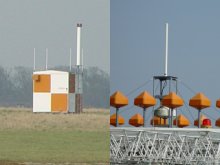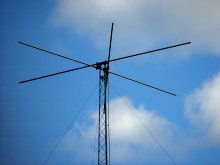| General
Principle
VORs operate in the 108 - 118Mhz VHF
range (just below the aircraft air-ground voice channels). They are low
power 25-100W and provide 5 degrees navigation accuracy.
The general principal of VOR technology
is to have two seperate 30Hz modulations on the VHF transmissions from
the VOR station. The VOR is arranged such that one of
the 30Hz signals remains in the same phase at all reception positions
around the VOR (Reference signal). The other 30Hz signal received (Variable
signal) will differ in phase by exactly the angular displacement of the
receiver around the VOR from the Zero radial. The aircraft receiver demodulates
the two 30Hz signals and simply compares their phase difference.
An audio ident in morse code at
1020Hz is also transmitted to enable pilot identification of the VOR tuned
and verification of its servicibility. Some VORs have speech audio channels
carrying ATIS or other ident info.
There are two main types of VORs in operation (ie two types of actual ground installation) but the aircraft receiver is the same for both. The receiver is unaware which type of ground station is in use - it experiences the same effects from both. It's the method of creation that differs.
Conventional
VOR - CVOR
The CVOR employs a rotating directional
antenna. Consider for a moment a directional antenna which has a transmission
pattern of one broad peak and one broad null in the horizontal plane.
If we were to feed this antenna with a VHF carrier and also rotate the
antenna at 30 revs/second (1800RPM) - think of how an AM receiver would
view this rotation. An AM
receiver would see a carrier amplitude modulated by a sine wave of 30Hz
- the phase of which would be determined by the receiver's position around
the station.
A practical CVOR doesn't actually
spin the aerial at 1800RPM (although the earliest ones did!) - it uses
electronic switching of an aerial array to achieve the effect. Additionally,
the reference signal is transmitted by FM modulating it onto a 9960Hz
subcarrier (deviation +/-480Hz). The reference signal provides the receiver its comparison
to station North. The receiver compares the AM 30Hz variable phase signal
recovered with the decoded 30Hz reference signal from the FM subcarrier and
determines the radial position from North on which the receiver lies.
Doppler VOR
- DVOR
The DVOR is a later and improved
design of VOR which suffers less from siting errors. The CVOR requires
a clear area of at least 1500ft in radius. The DVOR is more practical
in crowded areas or where there are tall buildings. However, it's a big
structure - around 100ft in diameter!
The DVOR reverses the useage of
the two 30Hz signals. However, by also reversing the direction of it's
rotating variable signal it produces exactly the same result in the receiver.
The receiver has no "knowledge" that it's a DVOR as opposed
to CVOR it's receiving and operates as normal.
In the DVOR the main VHF carrier
is AM modulated at 30Hz - providing the Reference signal. This is transmitted
from a central omnidirectional antenna and has the same phase all around
the VOR for any receiver.
The effect of a 9960 FM modulated
subcarrier is created using the Doppler effect by emplying a switched
array of antenna arranged in a circle of diameter 44ft. (This distance
being the exact amount to provide +/-480 apparent frequency shift in the
subcarrier.)
Imagine a carrier of FcMHz AM
modulated at 30Hz on the central antenna. Then imagine an array of an
even number of aerial elements arranged around the cental aerial in a
circle of diameter 44ft. (Typically 48 are used.) The VOR controller presents
the subcarrier as sidebands on the opposite ends of an imaginary arm.
Pairs of opposite aerials are switched in to form a rotating arm at 30Hz
(1800RPM). The opposite aerials elements carry sidebands of (Fc+9960Hz)
and (Fc-9960Hz).
From the receiver's perspective,
there's a constant phase 30Hz AM modulation on the main FcMHz carrier
but there also appears to be a 9960Hz subcarrier which is in turn frequency
modulated at 30Hz. The sidebands will appear to be frequency modulated
at 30Hz by +/-480 Hz due to the rotation and subsequent 44ft variation
in distance between transmitting aerial and receiver causing Doppler Shift
as the transmitting "arm" rotates. Of course, the phase of the
30Hz frequency modulation on the subcarrier (with respect to the reference
signal) will depend on the receiver's angular position around the VOR.
Hence, the same receiver comparison will result in the receiver's radial
position being established as in the CVOR.
|



